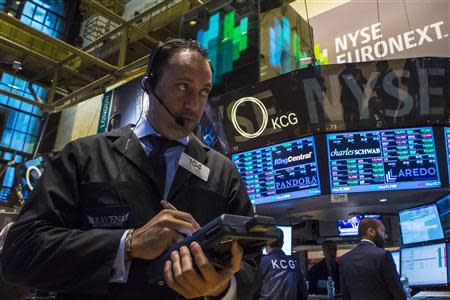Wall Street ends lower on worries of prolonged shutdown
By Angela Moon NEW YORK (Reuters) - Wall Street retreated on Wednesday, the second day of a partial U.S. government shutdown, as political wrangling in Washington raised investor concerns that the stoppage could be prolonged. Adding to worries, a report showed private employers added fewer-than-expected jobs in September. Investors were looking for more guidance from this data because Friday's broader, government payrolls report will be delayed if no deal on the budget is reached by then. Losses were across the board, led by stocks in the industrial sector , which fell 0.4 percent. The shutdown fight is rapidly merging with a higher-stakes battle over the government's borrowing power that is expected to come to a head soon. The Treasury has said the United States will exhaust its borrowing authority no later than October 17. "I wouldn't call the market's decline today a panic. But the longer this (shutdown) goes on, and the more headlines shift towards the October 17 deadline, investors are becoming more and more concerned," said Quincy Krosby, a market strategist for Newark, New Jersey-based Prudential Financial Inc. "As impossible as it seems, investors are thinking that there might now be a possibility of a default." The Dow Jones industrial average was down 58.56 points, or 0.39 percent, at 15,133.14. The Standard & Poor's 500 Index was down 1.13 points, or 0.07 percent, at 1,693.87. The Nasdaq Composite Index was down 2.96 points, or 0.08 percent, at 3,815.02. Congressional leaders and President Barack Obama planned to meet in the White House at 5:30 p.m. (2130 GMT) on Wednesday to discuss the budget impasse and raising the U.S. debt limit. Among individual stocks, the possibility of a second offer for Blackberry Ltd reversed a slide in its stock price after the struggling smartphone maker said it expected to record $400 million in pre-tax charges related to cuts announced last month. The stock ended up 0.3 percent to $78.06 after falling to a 11-month low earlier of $77.28. Despite the recent declines, buyers have come in as the S&P approached its 50-day moving average of 1,679.99. The moving average represents a measure of the near-term trend in the market and often investors will buy in clusters at such levels. The CBOE Volatility index , used to measure investor anxiety, rose 6.8 percent to 16.60. The index has gained more than 25 percent over the past two weeks. Trading volume totaled about 5.3 billion shares on the New York Stock Exchange, the Nasdaq and the NYSE MKT, below the average daily closing volume of about 6.3 billion this year. Declining stocks outnumbered advancing stocks by about 16 to 13 on the New York Stock Exchange while on the Nasdaq, decliners beat advancers by about 3 to 2. (Reporting by Angela Moon; Editing by Kenneth Barry)


